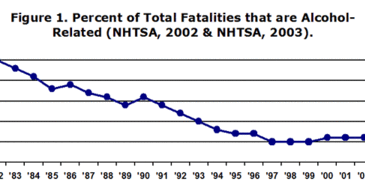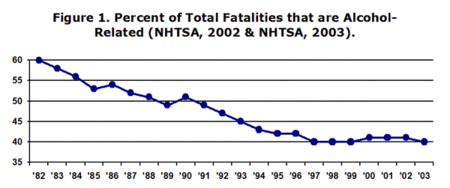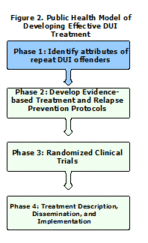Recent statistics from the National Highway Traffic Safety Administration (NHTSA) indicate that, in 2003, over 17,013 (40%) fatalities and approximately 442,960 (7%) of reported motor vehicle accidents were due to alcohol-related automobile accidents (NHTSA, 2003). Though it is encouraging that alcohol-related crash fatalities decreased by 5% between 1993 and 2003, the number of alcohol-related fatalities were approximately the same during both the beginning and ending years (i.e., 17,908 in 1993, 17,013 in 2003); sadly, the drop in percentage of alcohol-related motor-vehicle fatalities is due to an increase in the total number of vehicular accidents (i.e., 40,150 in 1993, 42,643 in 2003) (NHTSA, 2003). Further, the percentage of alcohol-related fatalities has hovered around 40-41% since 1997. These fatalities and injuries contribute to an enormous, but avoidable economic and social cost. Taylor, Miller and Cox (2002) estimated that the annual economic cost of alcohol-related motor vehicle accidents is roughly $51.1 billion.
A wide variety of policy interventions, including lowering the legal blood alcohol concentration and mandating stricter vehicle safety measures, have helped reduce the percentage of alcohol-related motor vehicle fatalities since 1982.
As Figure 1 illustrates, however, the previously steep decreasing trend in the proportion of alcohol-related traffic fatalities observable in the ‘80s and early ‘90s has bottomed out during recent years.
In July, 1998, four primary initiatives were adopted to address driving under the influence (DUI) offenses. As reported by NHTSA (2001), these include: (1) Licensing Sanctions, (2) Vehicle Sanctions, (3) Addressing Alcohol Abuse, and (4) Mandatory Sentencing. NHTSA reports that each of these initiatives has experienced some success. However, the recent leveling off of DUI fatality rates suggests that these initiatives have not yet been effective in further reducing DUI behavior. In addition, most recent available data shows that one-third of those arrested for DUI are re-offenders (NHTSA, 2001). This suggest that while current initiatives, such as licensing and vehicle sanctions, and mandatory sentencing, are significant consequences, they may not be sufficient to prevent chronic DUI offenders from returning to the steering-wheel under the influence once the sanctions are lifted and a sentence has been completed.
To effectively lower the rate and number of alcohol-related motor vehicle fatalities, initiatives must address the factors that lead to DUI offenses and particularly re-offenses. In addition, these efforts must establish swift and certain consequences for these actions. This could be achieved using a comprehensive public health strategy, which advocates a progression of efforts that begin with empirical research that will guide the implementation of effective evidence-based treatments.
As Figure 2 shows, the first phase of a public health approach to reduce and eliminate DUI and DUI relapse; these activities would determine the specific attributes of repeat offenders, perhaps the most dangerous of all DUI offenders, and empirically identify which attributes distinguish treatment-resistant repeat offenders from those who do not relapse under existing treatment methods. Although time consuming and labor intensive, this process allows for progression to the second phase of treatment development: the scientifically-guided modification of existing treatment programs and the development of new evidence-based treatment protocols that can maximize behavior change by targeting the identified attributes of repeat DUI offenders. These developmental steps can then be followed by two additional phases: testing and treatment dissemination.
Drinking and driving poses a continuing public health crisis and we must find a solution for this problem. Current methods of addressing this issue are mainly punitive and might have reached their maximum benefit. Systematic research following a public health model for developing effective treatment could be integral to stimulating another vital decline in DUI-related fatalities.
Contributors to this editorial include: Howard J. Shaffer, Richard A. LaBrie, Mark J. Albanese, Debi A. LaPlante, Sarah E. Nelson, Rachel C. Kidman, Anthony N. Donato, Michael V. Stanton, and Siri Odegaard.
References
National Highway Traffic Safety Administration. (2001). Repeat intoxicated driver laws. Retrieved September 16, 2003, from http://www.nhtsa.dot.gov/nhtsa/whatsup/tea21/tea21programs/164FinalRule.html
National Highway Traffic Safety Administration. (2002). Traffic safety facts 2001. Retrieved November 20, 2002, from
http://www-nrd.nhtsa.dot.gov/pdf/nrd-30/NCSA/TSF2001/2001alcohol.pdf
National Highway Traffic Safety Administration (2003). Traffic Safety Facts 2003. Retrieved January 10, 2005, from http://www-nrd.nhtsa.dot.gov/pdf/nrd-30/NCSA/TSF2003/809767.pdf
Taylor, D., Miller, T. R., & Cox, K. L. (2002). Impaired driving in the United States: State alcohol cost fact sheets. Retrieved January 21, 2003, from http://www.nhtsa.dot.gov/people/injury/alcohol/impaired-drivingusa/US.pdf






